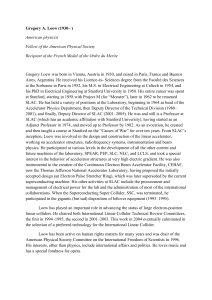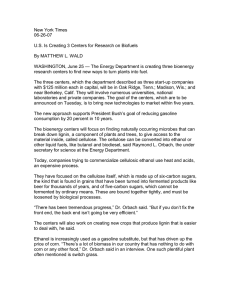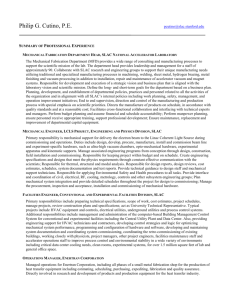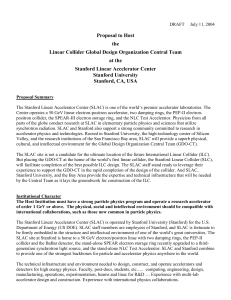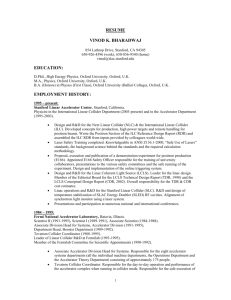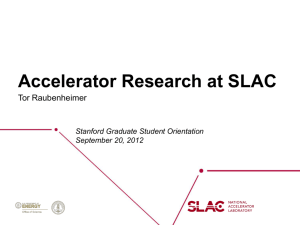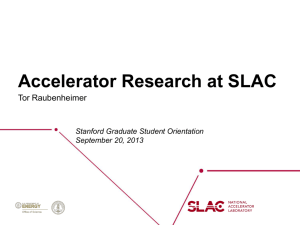Transcripts of Questions to Secretary Bodman
advertisement
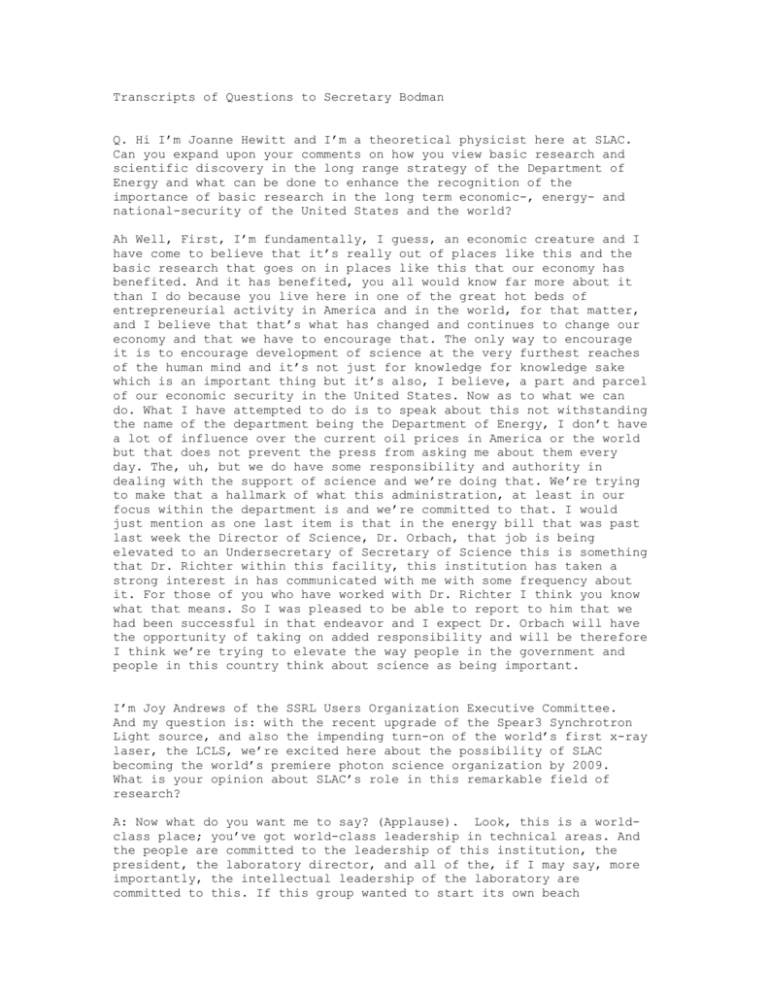
Transcripts of Questions to Secretary Bodman Q. Hi I’m Joanne Hewitt and I’m a theoretical physicist here at SLAC. Can you expand upon your comments on how you view basic research and scientific discovery in the long range strategy of the Department of Energy and what can be done to enhance the recognition of the importance of basic research in the long term economic-, energy- and national-security of the United States and the world? Ah Well, First, I’m fundamentally, I guess, an economic creature and I have come to believe that it’s really out of places like this and the basic research that goes on in places like this that our economy has benefited. And it has benefited, you all would know far more about it than I do because you live here in one of the great hot beds of entrepreneurial activity in America and in the world, for that matter, and I believe that that’s what has changed and continues to change our economy and that we have to encourage that. The only way to encourage it is to encourage development of science at the very furthest reaches of the human mind and it’s not just for knowledge for knowledge sake which is an important thing but it’s also, I believe, a part and parcel of our economic security in the United States. Now as to what we can do. What I have attempted to do is to speak about this not withstanding the name of the department being the Department of Energy, I don’t have a lot of influence over the current oil prices in America or the world but that does not prevent the press from asking me about them every day. The, uh, but we do have some responsibility and authority in dealing with the support of science and we’re doing that. We’re trying to make that a hallmark of what this administration, at least in our focus within the department is and we’re committed to that. I would just mention as one last item is that in the energy bill that was past last week the Director of Science, Dr. Orbach, that job is being elevated to an Undersecretary of Secretary of Science this is something that Dr. Richter within this facility, this institution has taken a strong interest in has communicated with me with some frequency about it. For those of you who have worked with Dr. Richter I think you know what that means. So I was pleased to be able to report to him that we had been successful in that endeavor and I expect Dr. Orbach will have the opportunity of taking on added responsibility and will be therefore I think we’re trying to elevate the way people in the government and people in this country think about science as being important. I’m Joy Andrews of the SSRL Users Organization Executive Committee. And my question is: with the recent upgrade of the Spear3 Synchrotron Light source, and also the impending turn-on of the world’s first x-ray laser, the LCLS, we’re excited here about the possibility of SLAC becoming the world’s premiere photon science organization by 2009. What is your opinion about SLAC’s role in this remarkable field of research? A: Now what do you want me to say? (Applause). Look, this is a worldclass place; you’ve got world-class leadership in technical areas. And the people are committed to the leadership of this institution, the president, the laboratory director, and all of the, if I may say, more importantly, the intellectual leadership of the laboratory are committed to this. If this group wanted to start its own beach volleyball team, I would bet on them. If they say we’re going to do this, I have no doubt they’re going to do this. They’re going to be very successful. Q: Hi, I’m Peter Tennenbaum and I’m an accelerator physicist and I’d like to know the secretary’s view, opinion, and policy on the linear collider, on the possibility of the future linear collider. A. I think that there will be a next generation of linear colliders built in America. I frankly don’t think it will be built here. I don’t think it will be built here. I don’t think from what I see from this facility or the land prices, of the surroundings, I don’t know where one would put it. A linear collider is by definition going to have to be a much larger scale even then what we have here today. We owe the current facility, our thanks to Dr. Panofsky and his colleagues for having created what’s here, which we continue to benefit from. I do think it will happen. I’d like to see it happen in America. I know that Dr. Orbach would and we will continue to work on that, but I think it would be very hard to have it here physically on this campus. Q. I’m Arthur Bienenstock, Stanford’s Dean of Research and former Director of the Stanford Synchrotron Radiation Lab. If you look at SLAC, it’s probably by far the most integrated of the national labs into a great research university. Yet, when we look to the future, that integration we believe will only increase with the development of particle astrophysics here with the ultra fast science sensor and with the mutual interest in next generation computing. What DOE goals and concerns should we take into account as we move into that direction? A. That’s a very good question, and the answer would be first of all, the Department is very pleased and proud of its association with Stanford. You’re also right to take note of the fact that this relationship is relatively unique where this facility is located on the grounds on the property of a great research university. We don’t have other that have that characteristic. From time to time, our research laboratories have fallen into bad habits, they’ve fallen into bad habits with respect to security of information. They’ve fallen into bad habits with respect to safety practices within the laboratory. When that happens, there is the inevitable response, as should be from our friends in Congress that would like to see that management’s responsibilities recomputed. I would implore Stanford to make sure that we do not have a repeat of what happened last year, and that the management practices of this institution, and I’m not worried about the science, I’m worried about the day to day management practices, the safety of the people, the security of the people, that’s what I mentioned in my remarks, that those be very high priorities. And, that they take an equal priority with the sciences so we can deal with excellence on both fronts and avoid confrontations that might evolve in the future. Q. Hi, I’m Steve Kahn, Deputy Director of the KILEY institute for particle astrophysics and cosmology. As you probably know Science Magazine recently ranked the question what is the universe made of as the most pressing unanswered science question of our time. I’m curious as to what your view is of the relevance of that question to the mission of the DOE and what plans you have for this department to help answer it? A. Far be it from me to challenge the wisdom of Science Magazine. Further far be it for me to challenge the wisdom of my long time friend Bob Wagner with whom I spoke with this morning and who told me much the same thing. I don’t know if it’s the most pressing question, it’s certainly one of the most pressing questions. Our job in the energy department in part (we have other responsibilities, but in part) is to encourage positive leadership in America in Science. I would leave it up to the scientific community to decide what the highest priority is. I’m a lonely engineer and if you all think that's the most important thing and can demonstrate your proficiency and competence in that field, which I believe you can, we will be very happy and eager to support it. Q. My name is Paul Styles and I’m an electronic engineer and in your speech you said that the private industry is funding the physical sciences less and less. Does the federal government or the DOE have a plan to reverse this? A. Well, it’s pretty m much what I said. I have a plan. These are very tough times in terms of budget flexibility in Washington these days and I am committed to search out ways of augmenting funding for science endeavors. But we are fundamentally dealing with a zero sum game. And that means the money will have to come out of somewhere else, presumably within our department. And if that’s the case, there will be repercussions there, so, its’ the idea of squeezing a balloon and it pops out of other places. So, we’re committed to it, I will follow through with it, I will be quite dogged on it and can commit that to you. We will see what happens but we’re right in the middle of creating budgets for ‘07, believe it or not, and we will be pursuing the matter with some vigor, and that’s all I can say before I see how the process works. Q. Hi, I’m Eric Colby, accelerator physicist. I have just one question. In addition to accelerator R&D for the next generation machines, like the ILC, we do longer range research aimed at higher gradient techniques, but it is fundamentally longer term research. Can you give some sense of the priority and resources for this research in the fu8ture? A. You know that’s something I would think, I’d have to consult with my friend Dr. Orbach in terms of how we deals with, but were I he in his job, I’d really leave a lot of that kind of judgment to the local leadership. These are people who work with you and have the expertise. Whether it’s long term or short-term, frankly that doesn’t bother me, personally that’s not the issue. The issue is whether it’s important and do we have a reasonable proposal that will lead to potential success in the future. Those are the issues and the whole question of peer review and getting input from others would be the determining factor in my mind, but I would tell you that I would defer to my friend Dr. Orbach and his colleagues on that. Q. Jonathan Dorfan: Let me wrap up perhaps with a question. WE at SLAC greatly benefit from interagency integration. By example, the NIH provided half the capital investment for Spear 3 and GLAST is being built as a very strong DOE-NASA collaboration. Do you envisage expanded cooperation of this kind in the future? A. I would think so, I would think hat just as you are finding more and more application for interdisciplinary work, even the government is finding it possible to get more done with less by working together and we are working actively with NASA and NIH as well as other departments. We’ve even had people from the Statement Department; we even had the Secretary of State over to our building the other day. It was astonishing. So we’re ever hopeful that we will be able to broaden the message of what we do, how we do it to the highest levels of the government and we are hopeful that we will be successful. Could I say one last thing and then I will let you wrap up? I am an engineer, I'm trained in technology and a product of what I would like to think is much the same process that went on a couple of generations ago from what you represent today. My purpose in this visit and in these visits is to get to know you, to hear your question and to try and respond to your concerns. I would hope that with time e I will grow to earn your trust and that as you look back on this, and look at the tenure of the four years that I will have this job, that you will look upon it as one of your own got the job and worked very hard to represent you.
